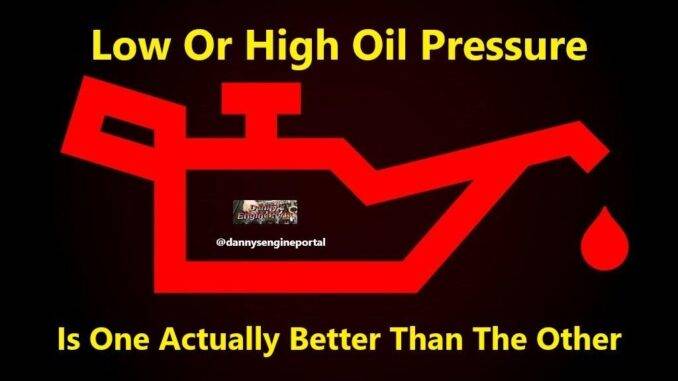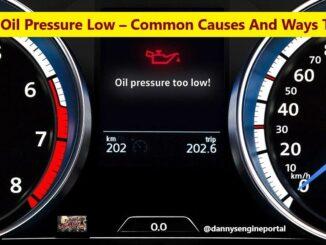
A customer changes his brand of oil and then, complains of low or high oil pressure.
So, is this perception or reality, and is one condition actually better than the other.
Why don’t customers complain about high oil pressure ? Low or high oil pressure, is caused by the resistance of the oil to flow (viscosity), under the pumping action of the oil pump.
And, having low or high oil pressure, is also affected by temperature.
First, when you start the engine, the oil is cold. So, the oil pressure should be higher than normal. But, once the engine is running, the oil is heated and flows much easier, thereby reducing the oil pressure. So, one of the biggest things that can affect oil pressure, is temperature. As a result, multi-grade engine oils came out, to even the playing field.
So, the oil pressure indicated on the gauge, shows the effort required by the oil pump to move the oil. But, the oil pressure indicated on the gauge, has nothing to do with the oil pressure, between the parts in the engine.
In The Following Discussion, We Hope To Demonstrate That:
- Low oil pressure is not necessarily bad. In fact, it can be very beneficial within reasonable limits.
- High oil pressure is not necessarily good. In fact, it can be a cause of great concern.
Engine Oil Flow Basics, With Low or High Oil Pressure
So, oil is sucked through the pickup screen, and then up the pickup tube into the oil pump. Now, this pump pushes the oil, through the filter and around the engine. Consequently, using the oil galleries and oil delivery holes. Usually located downstream of the filter, there is a oil pressure sending unit or transducer.
First, circulation of the oil is produced by, a oil pump and not a compressor. The most important criteria for good lubrication is, oil flow and not oil pressure. The oil pressure will vary considerably around the engine, declining with distance downstream, from the oil pump. As a result, pressure is negative, on the suction side of the pump.
What Causes, Low or High Oil Pressure
Oil pressure is caused by, the resistance of the oil to flow, under the pumping action of the oil pump. So, with wide oil galleries and low viscosity oil. The oil flow would be rapid and pressure would be low. Consequently, a very desirable condition for minimizing wear. But, under the same pumping conditions, with narrow oil galleries (by design or by blockage) and high viscosity oil. The oil flow would be slow, and pressure would be high. Therefore, resulting in less efficient lubrication.
So, a “good” oil has viscosity characteristics, sufficient to give good hydrodynamic lubrication of the loaded surfaces. But, flows around the engine well, to provide a continuous supply of fresh lubricant.
In extreme cases, a very viscous oil, would never get to the critical parts, to do its lubrication job. Note: in this case that engines do have bypass valves, to prevent excessive pressure in case of filter blockage.
Pressure Gauge Interpretation
When the engine starts, all the oil is in the sump and the pressure is zero. So, the pump cannot begin to deliver oil or generate pressure. Because, it has not sucked up oil, through the screen and the pick up tube. Hence, cold start lubrication needs to be increased. Consequently, by having a short, wide pickup tube and oil, that has very good cold flow properties. When the oil reaches the pump, it is then forced through the filter and then through the engine.
However, because the oil is still cold and the oil galleries are very narrow, flow is slow. As a result, a large back pressure develops, and the pressure gauge registers, a dramatic pressure increase.
So, as the oil circulates and warms up, it flows faster and the pressure declines, to a stable level. It is only at this point that the engine is being, properly lubricated.
Until stable oil pressure is obtained, wear rates are high, due to inadequate oil delivery to the wearing surfaces. So, under cold start conditions, a “good” oil is one which gives, stable oil pressure the fastest.
Under ideal circumstances, pressure should be stable. And, any large increase or decrease, should be investigated for possible mechanical damage.
Causes Of, Low Pressure Reading – Consequences – Action:
Low Oil Level
- Potential engine failure. Check the oil level and investigate the possibility of an engine oil leak.
Oil Not Flowing Into The Pump At Start-up
- Potential engine failure. Shut down the engine. Change to an oil with better low temperature properties. Improve cold start-up procedures.
Engine Lugging
- The oil pump runs too slow to deliver sufficient oil. Reduces engine life. Downshift to increase the engine (rpm). Finally, check the oil pump.
Oil Too Hot, Viscosity Too Low
- Oil breakdown, engine problems, wear and deposits. Check temperature gauge and engine temperature controls. Finally, check oil viscosity for correct grade.
Worn Oil Pump
- Will cause engine problems. Replace the pump.
Worn Bearings
- Engine problems. Oil flows through, increased clearance more easily. Replace bearings.
Fuel In Oil Reduces Viscosity
- Higher oil consumption. Engine wear. Avoid, excessive idling. Check injectors. Do a complete oil and filter change.
Oil And Filter Change
- Old oil had a higher viscosity, due to soot load and oxidation. Consequently, new oil flows better. None.
Causes Of, High Oil Pressure Reading – Consequences – Action:
Pressure Remains High, After Cold Start
- Oil flows adequately into the pump, but does not flow through the oil galleries. Potential engine failure. Shut down engine. Use oil with better low temperature properties (5W-30 or 0W-30).
Soot Load Causing Oil To Thicken
- Potential engine failure. Do a complete oil and filter change. Check injector performance. Avoid excessive idling.
Oxidation Has Thickened Oil
- Potential engine failure. Do a complete oil and filter change.
Oil Viscosity Is Too High
- Oil flow is poor. Potential engine failure. Consult owner’s manual/oil supplier, for correct viscosity grade. Do a complete oil and filter change.
Filter Blocked
- Bypass valve allows, unfiltered oil to circulate – Reduces engine life. Do a complete oil and filter change. Investigate cause of blockage.
Deposits In Oil Gallery System, Cause Increased Back Pressure
- Reduces engine life. Do a complete oil and filter change. Use a higher quality oil.
Oil Too Cold
- Potential engine failure. Check engine thermostat condition. Check that you have the correct oil viscosity.
Consequently, the customer/operator should be just as concerned with either low or high pressure. In fact any deviations, low or high, from “normal pressure” should be investigated, by an automotive mechanic.
Conclusion
So, higher pressure means that more work has to be done, to pump the oil around the engine. And, this loss of efficiency, should be minimized. As a result, high pressure, does not equate to good flow. Therefore, in many cases it is an indication of the opposite.
On the other hand, lower pressure, can mean that the oil is flowing rapidly around the engine. And, is a very desirable condition for minimizing wear.
BY DANNY BENDER




